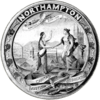Northampton, Massachusetts facts for kids
Quick facts for kids
Northampton
|
|||
|---|---|---|---|
| City of Northampton | |||
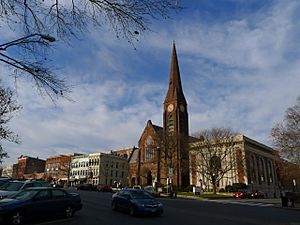
First Church, Main Street, Northampton
|
|||
|
|||
| Nickname(s):
The Meadow City
|
|||
| Motto(s): | |||
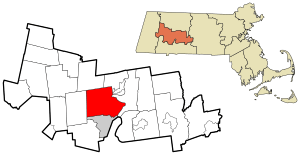
Location of Northampton in Hampshire County, Massachusetts
|
|||
| Country | United States | ||
| State | Massachusetts | ||
| County | Hampshire | ||
| Charter for township granted | May 18, 1653 | ||
| European settlers arrive | Early spring, 1654 | ||
| Established as a city | September 5, 1883 | ||
| Government | |||
| • Type | Mayor-council | ||
| Area | |||
| • Total | 35.75 sq mi (92.59 km2) | ||
| • Land | 34.25 sq mi (88.70 km2) | ||
| • Water | 1.50 sq mi (3.90 km2) | ||
| Elevation | 190 ft (60 m) | ||
| Population | |||
| • Total | 29,571 | ||
| • Density | 863.49/sq mi (333.40/km2) | ||
| Time zone | UTC−5 (Eastern) | ||
| • Summer (DST) | UTC−4 (Eastern) | ||
| ZIP Codes |
01060–01063
|
||
| Area code(s) | 413 | ||
| FIPS code | 25-46330 | ||
| GNIS feature ID | 0606674 | ||
Northampton is a city in Hampshire County, Massachusetts, United States. It is the county seat. In 2020, about 29,571 people lived in Northampton. This number includes its smaller villages, Florence and Leeds.
Northampton is known for its schools, arts, and music. It is a place where many people have open-minded views. The city is part of the Pioneer Valley and the Knowledge Corridor. This corridor is a partnership with other cities in the Connecticut River Valley. Northampton is also part of the Springfield Metropolitan Area. It is about 19 miles north of Springfield.
The city is home to Smith College, the Hotel Northampton, Northampton High School, Smith Vocational and Agricultural High School, and the Clarke Schools for Hearing and Speech.
Contents
History of Northampton
Early Settlement and Native Peoples
Northampton was originally called Norwottuck or Nonotuck. This name means "the midst of the river." The Pocomtuc people, who were Algonquian tribes, lived here first. They were often allied with the Mohican people.
Around 1606, the Mohawk people began attacking the Pocumtuc. A major smallpox sickness also hit the area in the 1630s. Because of these challenges, the Pocumtuc sold most of their land to settlers from Springfield, Massachusetts in 1653.
On May 18, 1653, the general court in Springfield approved the idea of a new town. Settlers arrived in early spring 1654 to create a permanent home. Later, the Pocumtuc and other Algonquian groups joined forces. They took part in King Philip's War against the colonists.
Changes in City Borders
Northampton's land grew over time. But then, parts of it were made into new towns. For example, Southampton became its own town in 1775. Westhampton was formed in 1778, and Easthampton in 1809.
A part of Northampton called Smith's Ferry was once cut off by Easthampton. The easiest way to get there was a road that often flooded. Smith's Ferry was given to Holyoke, Massachusetts in 1909.
The Great Awakening and Important Events
Jonathan Edwards was a famous preacher in Northampton. In 1734, he led a Christian revival that became very strong. This event spread and later led to the Great Awakening in 1739–1740. Edwards is seen as a founder of evangelical Christianity.
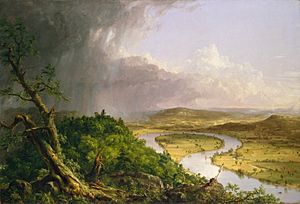
Northampton also had its own "witch trials" in the 1700s. However, no one accused of being a witch was put to death.
After the American Revolution, members of the Northampton community helped create the U.S. Constitution. In 1786, Daniel Shays and other veterans stopped the local court from meeting. This event was part of Shays' Rebellion.
In 1835, Northampton was connected to the ocean by the New Haven and Northampton Canal. This canal later failed and was replaced by a railroad. A big flood on the Mill River in 1874 destroyed most of the Leeds neighborhood.
The "Paradise of America"
From 1842 to 1846, Northampton was home to a special community. It was a utopian community of abolitionists. They believed that all people should have equal rights, no matter their gender, race, or religion. Sojourner Truth, a former slave and a national advocate for justice, lived here.
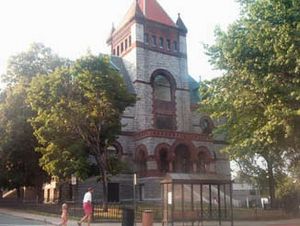
In 1851, the famous opera singer Jenny Lind called Northampton the "Paradise of America." This is how the city got its nickname, The Paradise City.
Clarke Schools for Hearing and Speech was started in Northampton in 1867. It was the first school in the U.S. to teach deaf students to speak and lip-read. Famous people like Alexander Graham Bell worked there.
Smith College for women was founded in Northampton in 1871. It is one of the largest Seven Sisters colleges. Many well-known women, including Sylvia Plath and Julia Child, went to Smith. The first game of women's basketball was played at Smith College in 1892.
Northampton officially became a city on September 5, 1883. Many immigrant groups, like the Irish, Polish, and French-Canadians, settled here.
U.S. President Calvin Coolidge worked as a lawyer in Northampton. He was the city's mayor from 1910 to 1911. After being president, he moved back to Northampton and died there in 1933.
Modern Northampton: A Cultural Hub
In the mid-1900s, Northampton faced economic challenges. However, it has since become a lively cultural center and a popular place to visit. The city has many unique restaurants and a vibrant arts and music scene.
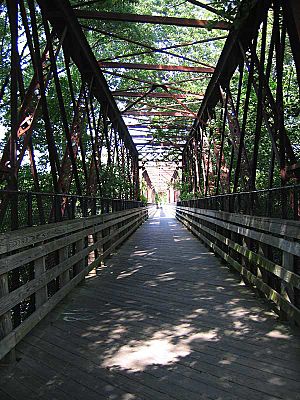
Northampton hosts an annual Pride event in May. It also has the Paradise City Arts Festival twice a year. This festival showcases modern crafts and fine art.
The city has a strong music scene with several venues. Many musicians and bands call this area home. Since 2004, Northampton has also hosted Django in June. This is a week-long Gypsy jazz music camp at Smith College.
Geography and Climate
Where is Northampton Located?
Northampton is on the west side of the Connecticut River. It is in the Pioneer Valley of western Massachusetts. The city covers about 35.75 square miles (92.6 square kilometers). About 21% of the city's land is protected open space.
The villages of Florence and Leeds are within Northampton's city limits. Northampton is bordered by Hatfield and Williamsburg to the north. Westhampton is to the west, and Hadley is to the east across the Connecticut River. Easthampton is to the south.
The art deco Calvin Coolidge Bridge connects Northampton to Hadley. The college town of Amherst is about 7 miles east. Springfield is 19 miles southeast. Boston is 104 miles east, and New York City is 161 miles southwest. The Oxbow of the Connecticut River is also within the city.
Northampton's Weather
Northampton has a humid continental climate. This means it has cold, snowy winters and warm, humid summers. Rain and snow are spread out evenly throughout the year. The city gets about 46 inches of precipitation annually.
| Climate data for Northampton, Massachusetts (01060) | |||||||||||||
|---|---|---|---|---|---|---|---|---|---|---|---|---|---|
| Month | Jan | Feb | Mar | Apr | May | Jun | Jul | Aug | Sep | Oct | Nov | Dec | Year |
| Record high °F (°C) | 70 (21) |
70 (21) |
85 (29) |
93 (34) |
94 (34) |
98 (37) |
100 (38) |
100 (38) |
99 (37) |
89 (32) |
82 (28) |
72 (22) |
100 (38) |
| Mean daily maximum °F (°C) | 33 (1) |
37 (3) |
45 (7) |
58 (14) |
69 (21) |
78 (26) |
82 (28) |
81 (27) |
73 (23) |
62 (17) |
49 (9) |
38 (3) |
59 (15) |
| Mean daily minimum °F (°C) | 13 (−11) |
16 (−9) |
24 (−4) |
35 (2) |
45 (7) |
55 (13) |
59 (15) |
58 (14) |
49 (9) |
38 (3) |
30 (−1) |
20 (−7) |
37 (3) |
| Record low °F (°C) | −30 (−34) |
−27 (−33) |
−17 (−27) |
11 (−12) |
24 (−4) |
32 (0) |
40 (4) |
32 (0) |
25 (−4) |
12 (−11) |
−4 (−20) |
−20 (−29) |
−30 (−34) |
| Average precipitation inches (mm) | 3.34 (85) |
3.23 (82) |
3.57 (91) |
3.87 (98) |
4.14 (105) |
4.10 (104) |
4.03 (102) |
3.76 (96) |
4.19 (106) |
4.64 (118) |
3.83 (97) |
3.44 (87) |
46.14 (1,171) |
| Source: Weather.com | |||||||||||||
People of Northampton
| Historical population | ||
|---|---|---|
| Year | Pop. | ±% |
| 1790 | 1,628 | — |
| 1800 | 2,190 | +34.5% |
| 1810 | 2,631 | +20.1% |
| 1820 | 2,854 | +8.5% |
| 1830 | 3,613 | +26.6% |
| 1840 | 3,750 | +3.8% |
| 1850 | 5,278 | +40.7% |
| 1860 | 6,788 | +28.6% |
| 1870 | 10,160 | +49.7% |
| 1880 | 12,172 | +19.8% |
| 1890 | 14,990 | +23.2% |
| 1900 | 18,643 | +24.4% |
| 1910 | 19,431 | +4.2% |
| 1920 | 21,951 | +13.0% |
| 1930 | 24,381 | +11.1% |
| 1940 | 24,794 | +1.7% |
| 1950 | 29,063 | +17.2% |
| 1960 | 30,058 | +3.4% |
| 1970 | 29,664 | −1.3% |
| 1980 | 29,286 | −1.3% |
| 1990 | 29,289 | +0.0% |
| 2000 | 28,978 | −1.1% |
| 2010 | 28,549 | −1.5% |
| 2020 | 29,571 | +3.6% |
| 2023 | 29,370 | −0.7% |
| * = population estimate. Source: United States Census records and Population Estimates Program data. Source: |
||
In 2010, there were 28,549 people living in Northampton. The city had 12,000 households. About 87.7% of the people were White. Other groups included 2.7% African American, 4.1% Asian, and 0.3% Native American. About 6.8% of the population was Hispanic or Latino.
The average age in the city was 40 years old. About 20.7% of the population was 19 or younger. The median income for a household was $56,999.
Education in Northampton
Public Schools
Northampton has four elementary schools for kindergarten through 5th grade. There is one middle school for grades 6 to 8. The city also has one high school (grades 9-12) and one vocational-agricultural high school (grades 9-12).
Colleges and Universities
Smith College is located in Northampton. It was founded in 1871 and is a women's college. Smith is part of the Five Colleges Consortium. Students from Smith and the other Five Colleges help create Northampton's lively college town feel.
Clarke Schools for Hearing and Speech
Clarke Schools for Hearing and Speech teaches deaf students to speak and lip-read. It is the oldest school of its kind in the country, started in 1867. Clarke also holds a summer camp each year.
Media and Communication
The Daily Hampshire Gazette is a local newspaper based in Northampton. It is the oldest newspaper still running in Massachusetts.
Northampton is home to several radio stations, including WLZX-FM, WEIB, and WHMP. There is also WXOJ-LP, a low-power community radio station called Valley Free Radio. It is run by volunteers and broadcasts music, news, and local shows.
Northampton Open Media (NOM) is a community media center. It provides public access to television and media tools. NOM has won awards for its websites.
Transportation
Roads and Traffic
Interstate 91 passes east of downtown Northampton. U.S. Route 5, Massachusetts Route 9, and Massachusetts Route 10 all meet in the city's downtown area. Massachusetts Route 66 is also partly in Northampton.
The city often has traffic jams in its downtown area. This is because there is only one bridge across the Connecticut River to Amherst. The city is working to fix these traffic problems.
Train Service
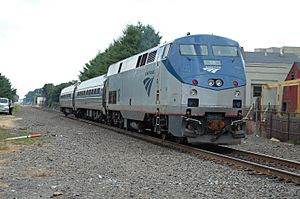
Northampton has passenger train service through Amtrak’s Vermonter and Valley Flyer lines. These trains connect Northampton to places like Springfield, New York City, and Boston. More frequent train service is available at Springfield Union Station, a 25-minute drive south.
Freight trains also use the rail lines in Northampton. Train service through Northampton stopped for a while but started again in 2014.
Bus Service
The Pioneer Valley Transit Authority runs local buses from Northampton. These buses go to nearby towns and colleges like Amherst College and the University of Massachusetts Amherst. The Franklin Regional Transit Authority also has a bus to Greenfield, Massachusetts. There is also a Peter Pan Bus stop for longer trips.
Airports
Northampton Airport is a small airport for private planes. The closest major airport is Bradley International Airport. It is about 27 miles south in Windsor Locks, Connecticut.
Biking Trails
Northampton is a center for rail trails. The Manhan Rail Trail goes from downtown into Easthampton. It is planned to eventually reach New Haven, Connecticut. The Norwottuck Rail Trail goes east from Northampton through Hadley and Amherst. The Northampton Bikeway goes through Look Park and into Haydenville.
Things to See and Do
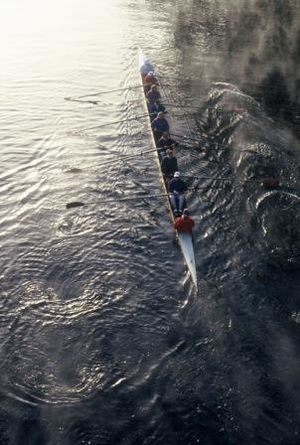
- First Church on Main Street was where Jonathan Edwards, a famous thinker, preached.
- The Elm Street/Round Hill Historic District has many old homes with different architectural styles.
- The Sojourner Truth Memorial in Florence honors Sojourner Truth, a former slave and advocate for equality.
- The Connecticut River and The Oxbow are popular for boating.
- Protected Open Spaces: 21% of Northampton is protected land. This includes places like Broad Brook/Fitzgerald Lake Conservation Area and Mill River Greenway.
- Look Park is a large park covering over 150 acres. It is free for people who walk or bike in. Famous musicians like Bob Dylan have played at the park's outdoor theater.
- Childs Park is a quiet 40-acre city park with ponds and gardens.
- The Botanic Garden of Smith College has many different trees, shrubs, and plants. It also has indoor greenhouses with plants from different climates.
- The Mill River Greenway is a walking path along the Mill River near Smith College.
- Rail Trails: Northampton is a hub for biking and walking trails. The Norwottuck Rail Trail is 18 miles long. The Manhan Rail Trail is 8 miles long.
- The Three County Fair is the "longest consecutive running agricultural fair in the country." It started in 1818.
- Music Venues: The Calvin Theater, Iron Horse Music Hall, and Pearl Street Nightclub are popular places for live music.
- The Academy of Music was built in 1890. It is one of the oldest city-owned theaters in the U.S. Famous performers like Harry Houdini performed there.
- The Northampton Independent Film Festival (NIFF) is held every fall. It is one of the largest film festivals in New England.
- Forbes Library is Northampton's public library. The second floor holds the Calvin Coolidge Presidential Library and Museum.
- Mirage Studios, the creators of the Teenage Mutant Ninja Turtles, were based in Northampton.
- Springfest is an annual event where students from the Northampton Community Music Center play music in the streets.
- LGBT Pride is an annual march and rally held in May. It includes a parade down Main Street.
- Thornes Marketplace in downtown Northampton has many shops and places to eat.
- Northampton State Hospital was a large hospital built in 1856. The site has been redeveloped.
- A stone monument marks the spot where two men, Domenic Daley and James Halligan, were wrongly put to death in 1806.
- Pioneer Valley Roller Derby trains in Florence.
Notable people
U.S. President Calvin Coolidge worked as a lawyer in Northampton. He was the city's mayor from 1910 to 1911. He later became Vice President and President of the United States. After retiring in 1929, Coolidge moved back to Northampton and died there in 1933.
Preah Maha Ghosananda, a Cambodian Monk and the Supreme Patriarch of Cambodia, died in Northampton in 2007.
See also
 In Spanish: Northampton (Massachusetts) para niños
In Spanish: Northampton (Massachusetts) para niños



